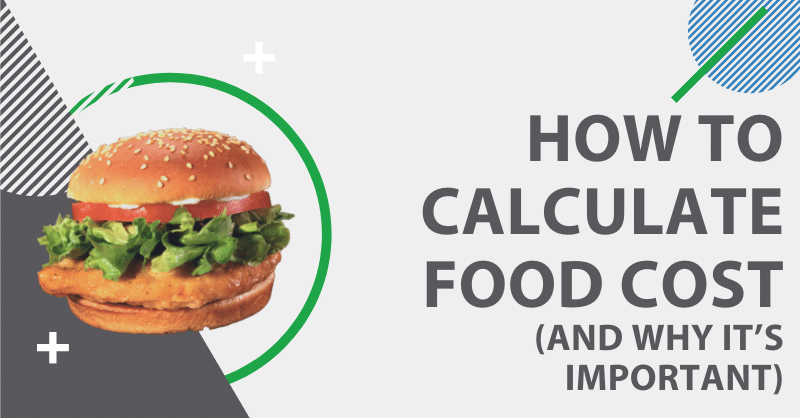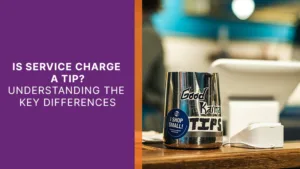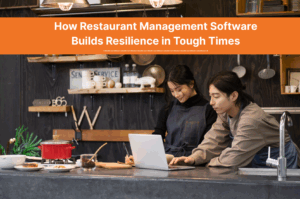Updated on: October 2, 2023
Food cost is one of the most important elements to consider if you hope to have any chance of running a profitable restaurant. After all, if you don’t know how to calculate food cost, you’ll never know how much you’re spending on the main thing that keeps customers coming through the door—the food.
Sure, there are other elements to consider like service, how much you’re paying your staff, and more. But before any of that, the food and how much it’s costing you is what you should get nailed down. Knowing your food cost is a critical first step. We’ll dive deeper into the specifics of why and show you how to calculate food cost so you can determine how much you should charge for each dish in order to make a profit and find sustainable success.
What is actual food cost?
Actual food cost accounts only for the cost of food and doesn’t relate it to anything else, like overall sales or margins. It’s a plain and simple, straightforward number that shows you how much your food costs and it considers even cooking mistakes, spoilage, and extra food left on plates. In short, anything you spend on food goes into this cost whether or not it’s eaten, or even purchased before being thrown out.
What is food cost percentage?
It’s a calculation that shows you how much of your overall sales go to food costs. In other words, food cost percentage shows the cost of ingredients as a percentage of sales. For instance, if you sold $1,000 worth of menu items and $500 on the actual ingredients, your food cost percentage would be 50%. More specifics on this later.
How do you calculate food cost?
Food cost is most often calculated as a percentage. Actual food cost gives you a good basic number to work from, but it doesn’t show the whole picture of how much your food cost is actually affecting your bottom line. In other words, when calculating food cost, it’s most helpful to actually know how to calculate food cost percentage to see a holistic view of how your restaurant is doing.
What is the formula for food cost percentage?
The formula for food cost as a percentage is pretty simple and can be done with a basic calculator (or reporting and analytics software). First, start with the total amount of food sales (usually not including alcoholic beverages). Next, determine the cost of the food used to make the dishes sold. After that, you can calculate it as a percentage. Here’s an example:
Total sales – cost of goods sold = total profit
$3,000 – $1,500 = $1,500
Total profit / total sales = food cost as a percentage (once multiplied by 100)
1,500/3,000 = .5
.5 x 100 = 50%
What is a good food cost percentage?
A good food cost percentage to shoot for is 28% of total revenue, though it could vary greatly depending on your individual restaurant. That means 72% of the money spent by a customer on a menu item should go toward things like paying cooks, paying servers, paying rent, and taking care of any other costs needed to keep your restaurant thriving. Only after that can you see how much of a profit you turned. As you’re aware, there are several costs to take into account when running your restaurant, so the lower you can get your food cost percentage while still maintaining quality menu offerings, the better.
What factors affect food cost?
A lot of factors affect food cost. Some of the most common things to take into account include your locale, the season of the year, the weather, diseases, and the fragility of the given ingredient, its scarcity, and the relative difficulty of growing or obtaining it.
For instance, if you’re selling seafood in a landlocked state like Nebraska, it’ll be much harder to obtain fresh fish than if you’re serving it from a coastal city in Florida where transporting it is much simpler. Also, if you’re trying to buy produce that’s out of season, prices may rise since additional measures may need to be taken to allow the fruit to grow more effectively even in changing weather conditions. You should also think about whether your food item needs to be refrigerated or handled with care. If it does, transporting it can be more costly.
How do you charge for food?
Knowing all this, how much should you charge for food? Well, there’s a lot to consider here. First, you’ll need to know your actual food cost. After that, you’ll want to think about all the expenses you have and see what kind of profit you’re looking at once that’s all paid. You’ll also want to take into account what the rest of the restaurant market is charging in your area for the same dish.
Does your restaurant use fresher ingredients or have anything that differentiates it enough to warrant a premium price? Maybe your brand name holds enough weight that you can charge more, or perhaps your service is superior. Obviously, whatever you can do to charge more for your food and pay less to buy the ingredients the better. It takes continual analysis and a decent amount of trial and error.
Don’t be surprised if it takes some time to nail down your pricing strategy. It’s not always easy to get it right, but taking the time to do your research is critical. Charge too little and you won’t turn a profit, but charge too much and you might lose customers. It’s a delicate balance, but with practice you can get it right.
Why is it important to know your food cost percentage as a restaurant?
If you know how much you’re spending on food in comparison to how much money your restaurant is bringing in, you can make informed decisions. Once you know your food cost percentage, it’s a lot easier to decide how much to charge for each dish. Not only that, it can also provide clarity on if you can afford to keep purchasing food from the same supplier, or if you’d be better off shopping around for different vendors.
Restaurants that consistently evaluate their food cost percentage are able to keep a better pulse on the overall financial health of their operation and make adjustments where needed. Many times, you may be able to find ways to reduce food cost without having to change menu offerings. Also, keep in mind that customer satisfaction is paramount, and that just because you can save money by eliminating a menu item doesn’t necessarily mean it’s the best idea for business. Be wise. Understand where you can save money, but be willing to splurge on certain food costs if there are specific food items or ingredients that make you unique and keep customers loyal.
How can you lower food costs?
Keeping food costs low is what will keep you in business. Lowering your food cost is easier said than done, but with diligent effort, it can be done. First take an inventory of what your food cost is currently and then break it down on an ingredient level. Which ingredient is most important? Could you afford to purchase cheaper ingredients for any part of a given dish without compromising on flavor? How do you get a good idea of how much you’re spending on each food item? The right technology helps. Read on.
Is there an easy way to track and analyze food cost?
Yes. Thankfully, with today’s technology, it’s easier than ever to keep tabs on how much you’re spending on food. Our inventory management software gives you a real-time look at inventory levels so you don’t waste valuable funds on excess food that will just get thrown away. When it comes to ordering, our purchasing software makes it simple to streamline your ordering processes, allowing you to order electronically and even automatically, saving time and money. To make the right decisions, you need the right data and analytics tools. Our restaurant reporting and analytics software can help you there. With it, you won’t have to worry about calculating food cost percentage. Instead, you can run a simple report that shows you this data.
What are the biggest takeaways when it comes to food cost?
When it comes to food cost there are a few things to remember. First, you need to have a good idea of how much you’re spending and how to calculate food cost as a percentage of overall sales. Next, once you know that number, you should consider all the factors and look for ways to reduce the cost. Lastly, in order to do that efficiently, you need the right tools at your disposal. That’s where we can help. If you’re ready to start analyzing your food cost more precisely so you can find ways to lower it, we’re here to make it happen.






